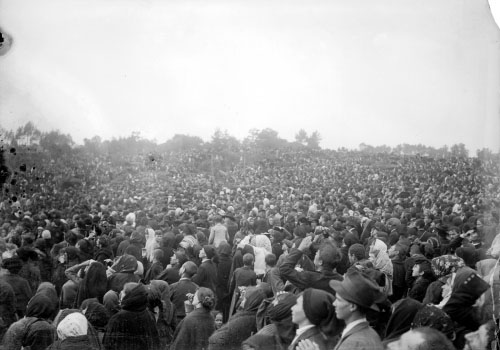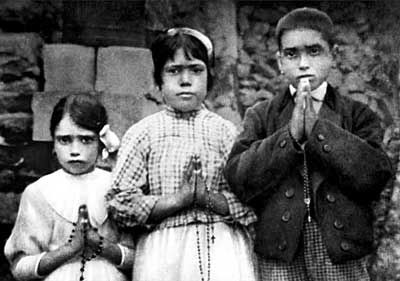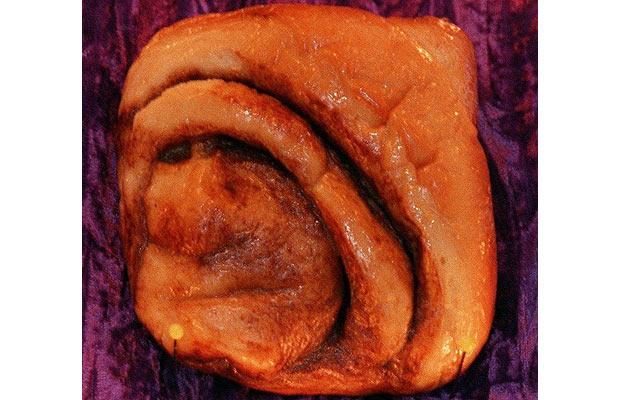The Lady of Fátima & the Miracle of the Sun

The story of a famous miracle in Fátima, Portugal, began in May 1917, when three children (ages 7, 9, and 10) claimed to have encountered the Virgin Mary on their way home from tending a flock of sheep. The oldest girl, Lucia, was the only one to speak to her, and Mary told the children that she would reappear to them on the thirteenth day of the next six months. She then vanished.
The children soon told their parents, and while some in the village didn't believe their tale, others did — and told more people. As the weeks and months passed, more and more of the faithful made pilgrimages to Fátima, where the children claimed to receive Mary's visits. Still no one else saw the Virgin Mary; instead, the gathered adults would stand riveted as Lucia took the lead and began to describe her visions.

It was Mary's final appearance, on Oct. 13, 1917, that became the most famous. In his book "Looking for a Miracle," Joe Nickell states that "an estimated 70,000 people were in attendance at the site, anticipating the Virgin's final visit and with many fully expecting that she would work a great miracle. As before, the figure appeared, and again only to the children. Identifying herself as 'the Lady of the Rosary,' she urged repentance and the building of a chapel at the site. After predicting an end to [World War I] and giving the children certain undisclosed visions, the lady lifted her hands to the sky. Thereupon Lucia exclaimed, 'The sun!' As everyone gazed upward, and saw that a silvery disc had emerged from behind clouds, they experienced what is known [as] a 'sun miracle'."
Not everyone reported the same thing; some present claimed they saw the sun dance around the heavens; others said the sun zoomed toward Earth in a zigzag motion that caused them to fear that it might collide with our planet (or, more likely, burn it up). Some people reported seeing brilliant colors spin out of the sun in a psychedelic, pinwheel pattern, and thousands of others present didn't see anything unusual at all.
The whole event took about 10 minutes, and this Miracle of the Sun, as it became known, is one of the best-known events at Fátima.
What happened at Fátima?
So what really happened at Fátima? What did the thousands of reporters and witnesses see? We can start by noting that we know for certain what did not happen: The sun did not really dance in the sky. We know this because, of course, everyone on Earth is under the same sun, and if the closest dying star to us suddenly began doing celestial gymnastics a few billion other people would surely have reported it. It's really not something that anyone else could have failed to notice.

This suggests that the experience was something else. In his book, Nickell suggested that the crowd saw a sundog, a patch of light that sometimes appears beside the sun. Sundogs are stationary, however, so that doesn't explain why people thought they saw the sun moving. So perhaps the "sun dance" appeared in the minds and perceptions of those pilgrims present — not in the skies above them. There must, therefore, be a psychological explanation, and indeed we can find one: an optical illusion caused by thousands of people looking up at the sky, hoping, expecting, and even praying for some sign from God. It is of course dangerous to stare directly at the sun, and to avoid permanently damaging their eyesight, those at Fátima that day were looking up in the sky around the sun, which, if you do it long enough, can give the illusion of the sun moving as the eye muscles tire.
The fact that different people experienced different things — or nothing at all — is also strong evidence of a psychological explanation. No one suggests that those who reported seeing the Miracle of the Sun — or any other miracles at Fátima or elsewhere — are lying or hoaxing. Instead they very likely experienced what they claimed to, though that experience took place mostly in their minds.
And what about the three young children whose visions of Mary put Fátima on the religious map? It's not clear what, if anything, they saw. For the believers, it made sense that Mary might only appear to (and speak to the world through) innocent peasant children, using their humble status to convey her messages of peace and spiritual salvation. Skeptics, however, noted that there was no real evidence of any miracles occurring, and suggested that Lucia was an imaginative girl who influenced her suggestible younger cousins.
There were other, lesser-known aspects of the Fátima story, including secret revelations and prophecies given to Lucia; as Nickell notes, several of the "prophecies" were true, but were actually written after they occurred, and thus were not true prophecies at all. [Related: Nostradamus: Predictions of Things Past]
Pareidolia and the power of suggestion
In addition, there was likely an element of mild mass hysteria involved, where one person sees something and gets excited about it, and others feed off it and start seeing similar things themselves. This is neither dangerous nor uncommon. Mass suggestion can be very powerful, and it's not difficult to find examples in which the religious mind sees images that may not really exist. In fact, Fátima is only one of hundreds of appearances claimed to be of the Virgin Mary over the centuries.

December 2010, for example, was an especially busy season for Mary, starting when a woman named Mari Valenzuela of Alhambra, California, noticed an image of the Virgin Mary in her melted candle. The lump, about an inch high and made of soft white wax, resembled a woman's head and torso. Valenzuela showed the miracle to her priest, who assured her that it was a sign that her life was on the right path. The Virgin Mary next showed up at a backyard barbecue in McAllen, Texas, when a guest noticed that a darkened oval knot in a wooden fence looked like Mary; her presence was credited with helping a woman recover well from a recent surgery. Then, a few days before Christmas, a woman in Dallas, Texas, photographed a transparent, oblong image through the back window of her Ford Expedition that she believed was of the Virgin Mary.
It's not surprising that human-shaped forms might be interpreted as religious figures, especially around the religious holidays. People see these images for the same reason that they see faces in clouds, Rorschach blots and coffee stains. This phenomenon, called pareidolia, is well known in psychology, and it is the cause of many supposedly mysterious and miraculous events (including the famous "Jesus in the Tortilla"). Whether the sightings are the result of a miracle or a mundane psychological process, they are welcomed by the faithful.
Benjamin Radford is deputy editor of Skeptical Inquirer science magazine and author of six books, including "Scientific Paranormal Investigation: How to Solve Unexplained Mysteries." His website is www.BenjaminRadford.com.
Sign up for the Live Science daily newsletter now
Get the world’s most fascinating discoveries delivered straight to your inbox.











